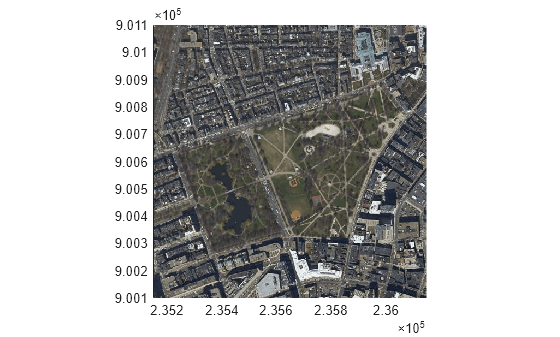worldfilewrite
Write world file from raster reference object
Description
Examples
Read an image as an array by using the imread function.
A = imread("boston_common.jpg");Spatially reference the image by creating a map cells reference object. For more information about how to spatially reference an image, see Spatially Reference Imported Rasters.
xlimits = [235150 236150];
ylimits = [900100 901100];
R = maprefcells(xlimits,ylimits,size(A),ColumnsStartFrom="north");Write the reference object to a world file. Get the filename for the world file by using the getworldfilename function.
filename = getworldfilename("boston_common.jpg");
worldfilewrite(R,filename)Verify the result. Read the world file into the workspace as a new reference object. Then, display the georeferenced image on a map.
newR = worldfileread(filename,"planar",size(A));
mapshow(A,newR)
The data used in this example is derived from data provided by MassGIS (Bureau of Geographic Information). See the file boston_common.txt for more details.
Input Arguments
Raster reference, specified as a GeographicCellsReference, GeographicPostingsReference, MapCellsReference, or MapPostingsReference object.
Filename, specified as a string scalar or a character vector. You can get the name
of a world file from the name of an image file by using the getworldfilename function. Common world file extensions include
.tfw, .jgw, and .pgw.
The way you specify filename depends on the location you are
writing to.
To write to the current folder, specify the name of the file, such as
"myWorldfile.tfw".To write to a folder different from the current folder, specify the full or relative path name, such as
"C:\myfolder\myWorldfile.jgw"or"dataDir\myWorldfile.pgw".
If filename is the name of an existing file, then
worldfilewrite overwrites the file. If filename
does not already exist, then worldfilewrite creates the file.
Data Types: char | string
Version History
Introduced before R2006aThe worldfilewrite function does not accept referencing matrices as
input. Use a geographic raster reference object (specified as a GeographicCellsReference or GeographicPostingsReference object) or a map raster reference object (specified
as a MapCellsReference or MapPostingsReference object) as input instead.
Reference objects have several advantages over referencing matrices.
Unlike referencing matrices, reference objects have properties that document the size of the associated raster, its limits, and the direction of its rows and columns.
You can manipulate the limits of rasters associated with reference objects using the
geocropormapcropfunction.You can manipulate the size and resolution of rasters associated with reference objects using the
georesizeormapresizefunction.
Depending on whether the referencing matrix is in geographic or planar coordinates, there are different ways to update your code.
Geographic Coordinates
If the referencing matrix is in geographic coordinates, create a geographic reference object.
Create a geographic reference object for a raster of cells by using the
georefcellsfunction.Create a geographic reference object for a raster of regularly posted samples by using the
georefpostingsfunction.Convert from a referencing matrix to a geographic reference object by using the
refmatToGeoRasterReferencefunction.
Once you have created a geographic reference object, replace uses of the referencing matrix in your code with the geographic reference object.
Planar Map Coordinates
If the referencing matrix is in planar map coordinates, create a map reference object.
Create a map reference object for a raster of cells by using the
maprefcellsfunction.Create a map reference object or for a raster of regularly posted samples by using the
maprefpostingsfunction.Convert from a referencing matrix to a map reference object by using the
refmatToMapRasterReferencefunction.
Once you have created a map reference object, replace uses of the referencing matrix in your code with the map reference object.
MATLAB Command
You clicked a link that corresponds to this MATLAB command:
Run the command by entering it in the MATLAB Command Window. Web browsers do not support MATLAB commands.
Sélectionner un site web
Choisissez un site web pour accéder au contenu traduit dans votre langue (lorsqu'il est disponible) et voir les événements et les offres locales. D’après votre position, nous vous recommandons de sélectionner la région suivante : .
Vous pouvez également sélectionner un site web dans la liste suivante :
Comment optimiser les performances du site
Pour optimiser les performances du site, sélectionnez la région Chine (en chinois ou en anglais). Les sites de MathWorks pour les autres pays ne sont pas optimisés pour les visites provenant de votre région.
Amériques
- América Latina (Español)
- Canada (English)
- United States (English)
Europe
- Belgium (English)
- Denmark (English)
- Deutschland (Deutsch)
- España (Español)
- Finland (English)
- France (Français)
- Ireland (English)
- Italia (Italiano)
- Luxembourg (English)
- Netherlands (English)
- Norway (English)
- Österreich (Deutsch)
- Portugal (English)
- Sweden (English)
- Switzerland
- United Kingdom (English)